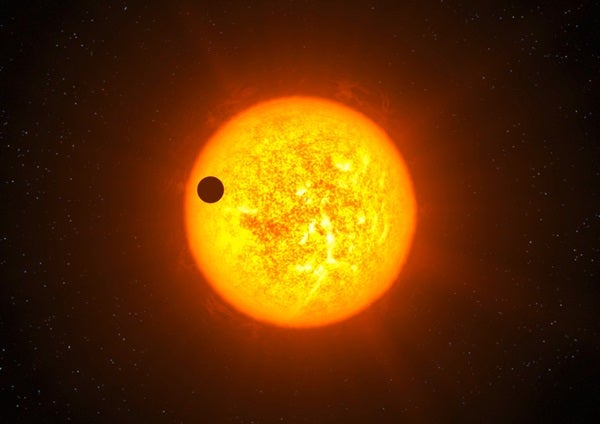Combining observations from the CoRoT satellite and the European Southern Observatory’s (ESO) HARPS instrument, astronomers have discovered the first “normal” exoplanet that can be studied in great detail. Designated Corot-9b, the planet regularly passes in front of a star similar to the Sun located 1,500 light-years away from Earth towards the constellation Serpens.
“This is a normal, temperate exoplanet just like dozens we already know, but this is the first whose properties we can study in depth,” said Claire Moutou, who is part of the international team of 60 astronomers that made the discovery. “It is bound to become a Rosetta stone in exoplanet research.”
“Corot-9b is the first exoplanet that really does resemble planets in our solar system,” said Hans Deeg, lead author. “It has the size of Jupiter and an orbit similar to that of Mercury. Like our own giant planets, Jupiter and Saturn, the planet is mostly made of hydrogen and helium,” says team member Tristan Guillot, “and it may contain up to 20 Earth masses of other elements, including water and rock at high temperatures and pressures.”
Corot-9b passes in front of its host star every 95 days, as seen from Earth. This “transit” lasts for about 8 hours, and it provides astronomers with much additional information on the planet. This is fortunate as the gas giant shares many features with the majority of exoplanets discovered so far.
“Our analysis has provided more information on Corot-9b than for other exoplanets of the same type,” said co-author Didier Queloz. “It may open up a new field of research to understand the atmospheres of moderate- and low-temperature planets and, in particular, a completely new window in our understanding of low-temperature chemistry.”
More than 400 exoplanets have been discovered so far, 70 of them through the transit method. Corot-9b is special in that its distance from its host star is about ten times larger than that of any planet previously discovered by this method. And unlike all such exoplanets, the planet has a temperate climate. The temperature of its gaseous surface is expected to be between 320° and -4° Fahrenheit (160° and -20° Celsius), with minimal variations between day and night. The exact value depends on the possible presence of a layer of highly reflective clouds.
The CoRoT satellite, operated by the French space agency CNES, identified the planet after 145 days of observations during the summer of 2008. Observations with the very successful ESO exoplanet hunter — the HARPS instrument attached to the 3.6-meter ESO telescope at La Silla in Chile — allowed the astronomers to measure its mass, confirming that Corot-9b is indeed an exoplanet, with a mass about 80% the mass of Jupiter.










